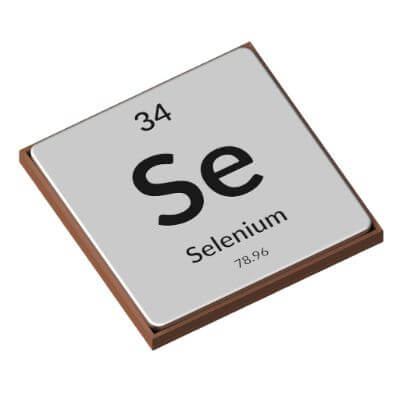
- Name: Selenium
- Symbol: Se
- Atomic Number: 34
- Atomic Weight: 78.96 u
- Period: 4
- Group: 16 (oxygen group)
33 Selenium Facts for Kids
- Selenium is a chemical element on the periodic table.
- Selenium is a nonmetal and can vary in color from black, gray to red.
- Selenium is named after Selene, the goddess of the Moon in Greek mythology.
- Selenium was discovered in 1817 by Swedish chemists Jöns Jacob Berzelius and Johan Gottlieb Gahn.
- The symbol for selenium is Se.
- The atomic number for selenium is 34.
- The standard atomic weight of selenium is 78.96 u.
- Selenium is a solid at room temperature.
- Selenium is in the reactive nonmental element category on the periodic table.
- Selenium is a period 4 chemical element, which is the fourth row on the periodic table.
- Selenium is a group 16 chemical element, which is the oxygen group.
- Selenium is in the p-block on the periodic table.
- The electron configuration for selenium is [Ar] 3d 10 4s2 4p4.
- The electrons per shell for selenium are 2, 8, 18, 6.
- Selenium has five stable isotopes.
- The five stable isotopes for selenium are 74Se, 76Se, 77Se, 78Se, and 80Se.
- The melting point for selenium is 430 °F (221 °C).
- The boiling point for selenium is 1265 °F (685 °C).
- According to the USGA, the world refined over 3 million tons of selenium in 2018.
- According to the USGA, the largest refiner of selenium in 2018 was China with over 1 million tons.
- According to the USGA, China refined more than 33% of the world’s supply of selenium in 2018.
- Based on data from the USGA, the world’s proven reserves of selenium as of 2018 is over 109 million tons.
- Based on data from the USGA, China holds over 25% of the world’s proven reserves of selenium as of 2018.
- Around 50% of all selenium production goes towards glass production.
- Selenium is used as an alternative to lead in several different metal alloys.
- The photoconductive and photovoltaic properties of selenium make it useful for light meters, photocells and photocopying and solar cells.
- Copper indium gallium selenide solar cells (CIGS cell) are made with selenium. They are a second generation solar cell that is much thinner than the first generation.
- There is a lot of potential with lithium–selenium (Li–Se) batteries, it is an excellent alternative to lithium–sulfur batteries because of its high electrical conductivity.
- The compound selenium dioxide (SeO2) is used during the electrowinning of manganese to reduce the power usage needed to operate electrolysis cells.
- The compound zinc selenide (ZnSe) was the first compound used in LEDs for blue light, but the use of zinc selenide has faded in favor of gallium nitride.
- Selenium is an essential micronutrient for animals and humans but can be toxic in big amounts.
- The primary dietary source of selenium is from cereals, meats, mushrooms and nuts.
- The U.S. Dietary Reference Intake (DRI) recommends a healthy adult human should intake 400 mcg of selenium a day.
Additional Resources on Selenium
- Selenium (Se) – Discover more about the chemical element selenium on the Los Alamos National Laboratory website.
- Selenium for Kids – Find more information about the chemical element selenium for kids on the Britannica Kids website.
- Selenium and Your Health – Learn about the benefits and/or risks of selenium to your health on the National Institute of Health website.
- Selenium – PubChem – Read more about selenium and the data behind it on the NIH PubChem website.
